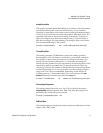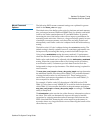
StorNext File System Tuning
The Metadata Controller System
StorNext File System Tuning Guide 12
Settings greater than 64K are not recommended because performance
will be adversely impacted due to inefficient metadata I/O operations.
Values less than 16K are not recommended in most scenarios because
startup and failover time may be adversely impacted. Setting
FsBlockSize to higher values is important for multiterabyte file systems
for optimal startup and failover time.
The best rule of thumb is to use 16K unless other requirements such as
directory ratio dictate otherwise.
This setting is not adjustable after initial file system creation, so it is
very important to give it careful consideration during initial
configuration.
Example:
FsBlockSize 16K
JournalSize 0
The optimal settings are in the range between 16M and 64M. Avoid
values greater than 64M due to potentially severe impacts on startup and
failover times. Values at the higher end of the 16M-64M range may
improve performance of metadata operations in some cases, although at
the cost of slower startup and failover time. A good rule of thumb is to
use 16M unless another requirement dictates differently. This setting is
adjustable using the
cvupdatefs utility. For more information, see the
cvupdatefs man page.
Example:
JournalSize 16M
SNFS Tools 0
The snfsdefrag tool is very useful to identify and correct file extent
fragmentation. Reducing extent fragmentation can be very beneficial for
performance. You can use this utility to determine whether files are
fragmented, and if so, fix them. If your files are prone to fragmentation
you should also use the FSM config file tuning options to minimize
fragmentation. These global configuration settings are
InodeExpandMin,
InodeExpandInc, and InodeExpandMax. (For more information, see the
Note: This is particularly true for slow CPU clock speed metadata
servers such as Sparc. However, values greater than 16K can
severely consume metadata space in cases where the file-to-
directory ratio is low (e.g. less than 100 to 1).


















